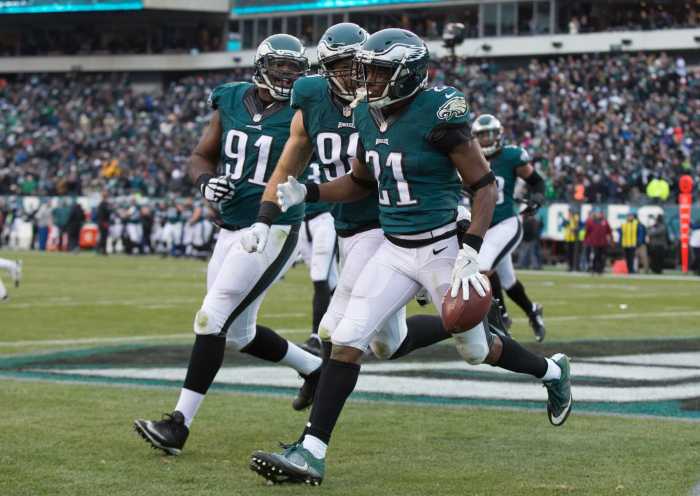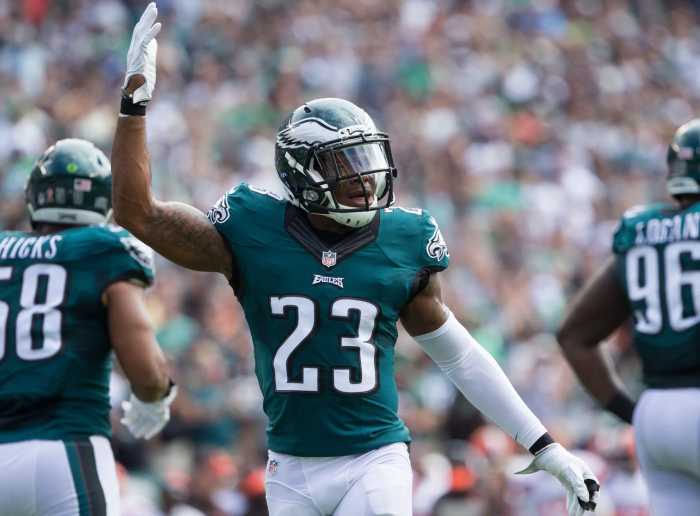Today on Know your Eagles Enemy, we’ll be looking at the last position group of our red and white rivals, the Washington Redskins. This group is pretty young at some key positions going into this season and is banking on some players fulfilling their potential in a hurry. It’s happened for the ‘Skins in the past, will they strike gold again? Can Josh Norman still compete at the age of thirty? Let’s get into it.
Washington was too often overlooked as a talented pass defense last season due to their atrocious attempts trying to stop the run. They finished the year ranked 9th in total passing yards allowed, conceding 213.75 yards per game through the air. The underlying concern is they still surrendered 7.0 yards per pass attempt, finishing 16th in the league. Accordingly, they faced the 3rd least wide receiver targets, 4th fewest wide receiver receptions and yet allowed the 7th most WR yards, and 8th most WR touchdowns (per Football Outsiders). They also caused 16 interceptions, tied for 9th. The problem for the ‘Skins wasn’t necessarily ability – they were the 6th most efficient pass defense according to Football Outsiders – it was consistency. For example, after holding Derek Carr and the Raiders to 118 yards passing, they gave up 293 in the air to Alex Smith’s Chiefs and 245 yards to a CJ Beathard-lead San Francisco in consecutive weeks.
| Targets per Game | Yards per Game | Yards per Target | |
| Redskins vs. #1 WR | 6.6 | 55.5 | 8.4 |
| NFL vs. #1 WR | 7.9 | 65.0 | 8.2 |
| Redskins vs. #2 WR | 4.5 | 41.9 | 9.3 |
| NFL vs. #2 WR | 5.8 | 44.3 | 7.6 |
| Redskins vs. #3+ WR | 6.1 | 38.4 | 5.7 |
| NFL vs. #3+ WR | 6.1 | 44.8 | 7.3 |
Above is a breakdown of the team’s efficiency against opposing receivers. It can be a tad difficult to decipher due to the fact that the team’s top corner Josh Norman, does not follow opponent’s top receivers around the field. Instead he remains on the right side. What we can deduce, after examining the top receivers the team faced last season – Washington has a hard time covering smaller, quicker number two receivers, than typically large, lanky number ones. The teams which threw for the most yards against this secondary (Kansas City, New Orleans, Los Angeles Chargers) have speedy number one receivers. The two exceptions, Philadelphia and Minnesota, benefited from fantastic performances from their faster receiving options. Vikings’ receiver Adam Theilen went for 166 yards and Nelson Agholor and Mack Hollins added touchdowns for the Eagles. Similarly, the Redskins were a much better defending the short-pass (4th) than the deep-ball (20th). In fact, according to Football Outsiders, opposing offenses had 74.9% and 70.6% efficiency rates when targeting the deep middle and deep right of the defense, respectively. They averaged -5.8% efficiency when targeting the deep left — the position formerly manned by Bashaud Breeland. The performance of the pass defense emphatically mirrors the expertise of their top corner Josh Norman.
At this point in his career, the league knows what Josh Norman is about. He is long, strong and mean. While he suffered a down season in 2017 while fighting through injury, Norman is an undisputed leader in the secondary. He brings a toughness and a swagger to the room that is difficult to measure. Looking to bounce back from his first season without an interception since a 2013 season in which he barely played, he will have to hold off father time. He was clearly missing a step in coverage last year, and whether due to injury or age, he got burnt deep more times than you’d like from your number one corner. He will still be able to disrupt short routes with a powerful jam and good underneath technique. Generally, the veteran will be able to make up for a loss in speed with fantastic ball skills and an unmatched physicality, but he may have trouble keeping up with the speedsters in the division. The first play in the video below is a perfect example of the best and the worst of Norman’s coverage. He clearly gets beat, but with good positioning, tracking and an under-thrown football, he is able to make a play and cause a near interception.
https://www.youtube.com/watch?v=0MFc0n-EnYk
Regardless of a possible decline in pass coverage, Norman should remain one of the premier run-defending defensive backs.
He will be flanked by Quinton Dunbar on the left side. The key to Dunbar’s game is versatility: he is able to hold his own on the inside or outside. The former Florida wide receiver transitioned to corner after going undrafted. The biggest issue with his game is that he still plays like a converted corner. The decision to draft the 6’2” 200-pounder came down to measurables. He has improved every year and performed admirably when thrown in the line-up last season. The combination of he and Fabian Moreau’s performance prompted the front office to allow Bashaud Breeland to leave in free agency and made Kendall Fuller expendable in the trade for Alex Smith. The verdict is still out on whether that was a wise decision. Dunbar was Bleacher Report’s 60th ranked corner (Breeland was ranked 21st). In his write-up they stated: “ideally a third corner who rotates in.” With what he’s shown, it’s hard to argue with that. Perhaps the Redskins have seen enough development from the transitional project, but stiff hips and difficulties tracking the ball in the air have been, and continue to be Dunbar’s downfall. The question becomes, at what point is will he no longer be considered a “converted” corner?
Taking over in the slot for Fuller will most likely be second-year pro Fabian Moreau. The Redskins brought in former Cowboy Orlando Scandrick, presumably to man the slot corner role, only to promptly release him citing confidence in their young defensive backs. To be fair, Scandrick wasn’t a world-beater to begin with. Confidence did wonders for Fuller last season, quickly becoming one of the league’s better young slot corners – perhaps it will do the same for Moreau. The UCLA product is another converted corner, coming into college as a running back. You’ll notice that Washington covets defensive backs who have experience at other positions. Accordingly, he has a thick frame and his strong lower body makes him hard to push off the line of scrimmage. Despite his width, Moreau is incredibly quick, although not the most fluid. He is still learning the position and lacks some discipline, but will make up for it with a quick break on the ball and physicality at the line. Subsequently, he is better in tight man coverage than off coverage. At the end of the day, Moreau is a possible first-round talent that fell to the third due to injury concerns. If defensive backs coach Torrian Gray and defensive coordinator Greg Manusky are able to develop him in the same fashion as Fuller, he could be a surprise in the slot.
Beyond the ingrained starters, the Redskins have a lot of youth at corner. The best of the bunch is 2018 7th-round pick Greg Stroman. The Virginia Tech alum will be reuniting with former coach Torrian Gray in Washington. So far during the preseason, Stroman has consistently been around the football. He played 57 snaps against the Patriots, tied for the most on defense. In coverage, he displays quick, fluid hips and good recovery speed. At 5’11” 182 pounds, he can be out-jumped and will get out-muscled. Correspondingly, he is not an overwhelming tackler or a commanding presence in run support. All that considered, in his last collegiate season he made a play on 37% of passes thrown his direction and allowed only 25.6% of those passes to be completed. If nothing else, he should make the team due to special teams value. He is currently the primary returner on the unofficial Redskins depth chart. In the video below, you’ll see his return ability at 0:15. The rest of the highlights showcase his ability to be in the right place at the right time, resulting in multiple interceptions on poorly thrown balls.
The Redskins also used a supplemental 2018 draft pick on former Virginia Tech corner Adonis Alexander. He’s long and lanky, with a strong jam and solid tackling ability. With fluid hips and good ball skills, he’ll remind a lot of people of his teammate Josh Norman. Pegged as a 3rd or 4th round talent, Alexander was ineligible for the 2018 NFL draft due to off field issues in college. He was suspended in 2016 due to a marijuana arrest, and in 2017 for violating team rules. He has been criticized for an inconsistent motor, and his 2016 tape was much better than 2017. Some think he will be a better fit at safety, but he will be re-joining his former DBs coach, under whom he had his best season at corner. He hasn’t yet had the opportunity to display his true potential this off season after joining the team late, but look for him to get opportunities as the year goes on.
The final promising young corner on the roster is second year player Josh Holsey. While not a lock to make the final 53, the coaching staff have liked what they see from Holsey. He is a cerebral player with below average size and athleticism. However, injury concerns – he had ACL surgery in 2013 and 2015 – may prevent him from making a tangible push for playing time in the slot.
Taking up the first position at the back end of the defense, DJ Swearinger is one of the unquestioned vocal leaders of the defense. As seen in the recently circulating video from joint practices with the Jets, and former teammate Terrelle Pryor, the safety has no trouble making himself heard, or getting inside the heads of his opponents. DJ Swearinger the football player isn’t half bad either. A very technically sound safety, he is more of a thumper than a finesse player. After finishing last season with 89 total tackles, four interceptions, a forced fumble and 0.5 sacks, he was Bleacher Report’s 14th ranked free safety. The video below includes countless examples of his ability as an aggressive run defender. He demonstrated his downhill run support at 0:44. At 2:22, Swearinger quickly diagnoses the stretch zone blocking scheme, recognizes that his outside linebacker is able to maintain the edge and comes downhill to make a strong tackle. Again, at 2:36, he arrives like lightning, meeting Elliot in the backfield. In terms of pass coverage, he is best in off man, where he can attack the football – the interception at 4:13 being an example. He has limited recovery speed, but is savvy enough to keep the play in front of him. With the return of Nicholson, Swearinger will be able to return to playing in the box, where he is at his best. This should also help him take advantage of his underrated blitzing ability.
The other safety spot will be filled by second year pro Montae Nicholson. Drafted in the 4th round, Nicholson had to sit out the off-season after suffering a shoulder injury. He then went down in week 11 with another injury after only playing 8 games. Coach Jay Gruden and DC Greg Manusky have repeatedly praised his athleticism. He was a track runner in college, which translated to a 4.42 40-yard dash and real on-field speed in the NFL. Nicholson often shows off his quick break on the ball and comes with a fury, frequently making jarring hits. The limited tape available from his first season reminds me of an early Rodney McLeod. In spite of his clear athleticism and feel for the position you just don’t feel entirely comfortable with him back there. He’ll make some exciting interceptions and thumping hits over the middle, but he’s susceptible to missed tackles and bad angles. Most of the time he will make up for it with his motor and athleticism. This is a recurring theme in the Redskins’ secondary: sacrifice intangibles for plus athletes and versatility as an added bonus. Nonetheless, Nicholson’s position seems all but cemented. D.J. Bland quoted coach Gruden stating: “[Montae] is a really important piece. Very similar to the way Jordan Reed is on [offense].” The comparison is apt. Both players have struggled with injuries, but when healthy can be game-changing presences.
Behind Nicholson and Swearinger, the third safety position will be occupied by 2018 4th round pick Troy Apke. Again, Apke is a talented athlete with limited experience and will be a developmental project for at least a season. He was only a one-year starter at Penn State. However, he displays good play recognition and will often put himself around the ball. The former high school track star turned heads by running a blazing 4.34 second 40-yard dash at the NFL combine. He has average ball skills and will need to develop as a deep safety. Apke is a solid downhill run defender, but struggles with missed tackles. Special teams value will keep him on the field in his first season. Leading up to the draft, he was the MVP of the NFLPA Collegiate Bowl registering seven tackles, one interception and a forced fumble. Coach Mike Martz was very impressed, expressing: “I think in the four years that I’ve coached that [NFLPA] bowl game, he’s the best player we’ve had,” per Land of 10. Below you’ll see an example of his incredible recovery speed.
Trying to watch film on LB Jason Cabinda but Troy Apke (#28) is everywhere. pic.twitter.com/28sl77hOdZ
— Cover 1 (@Cover1) April 20, 2018
Best Case: After it’s all said and done, I don’t think this unit is better on paper than it was last season. If anything, they might be as good and healthier. However, a lot can come from what figures to be an upgraded pass rush. The thing to note is: if the defensive line and by extension the run defense does improve, this secondary could see a lot more action. That’s not exactly the scenario you hope for with some young players in important positions. As long as Coach Manusky can keep the short-ball defense ticking, the pass rush and plethora of budding athletic corners should alleviate some deep ball pressure. With a lack of proven depth, early injuries could be concerning. This is especially the case at safety, where they no longer have DeAngelo Hall to step in as a stopgap. Ninth or tenth in passing yards allowed sounds about right, but if the defensive line develops quicker than expected, you could see an increase in turnovers.
Worst Case: Letting go of Kendall Fuller could prove to be a big mistake. Even Montae Nicholson was publicly upset about it. You can Google his tweets if you’re interested. If the pass rush does not go as planned, making Quinton Dunbar – a man who struggles to track the ball downfield – a full time starter in a defense that struggles to defend the deep ball could be costly. A lot of this group is based on potential. The other part is heaped on the shoulders of Josh Norman to continue to produce at a number one corner level at the age of thirty. A couple bad or nagging injuries could really put this group in a hole.
Mandatory Credit: Geoff Burke-USA TODAY Sports




























